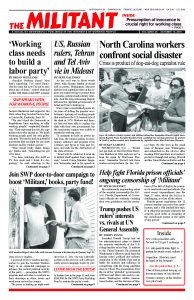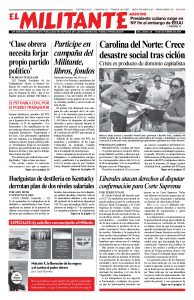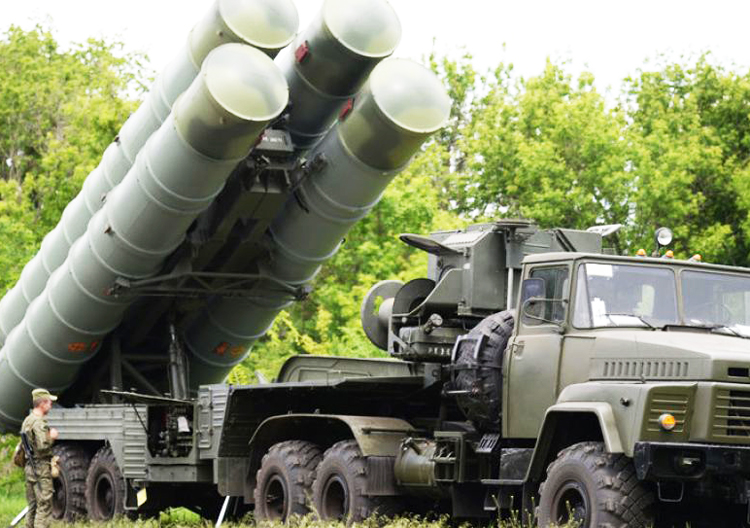As the civil war in Syria winds down, with dictator Bashar al-Assad still in power, Washington, Moscow and the rival capitalist rulers in the region are maneuvering to protect their economic, political and military interests. And the long-simmering dispute between the capitalist governments of Israel and Iran is heating up.
Iran’s rulers consolidated power after years of stifling the popular revolutionary uprising of working people that overthrew the U.S.-backed rule of the shah in 1979. Workers and farmers had not been able to replace the shah with their own government, but the reactionary regime was unable to smash the working class.
To maintain its hold on power inside Iran, the regime pushes its reactionary influence and program from Lebanon and Syria to Iraq and Yemen, and calls for the destruction of the state of Israel.
“Israel will do whatever it must do to defend itself against Iran’s aggression,” Israeli Prime Minister Benjamin Netanyahu said in his speech to the 73rd United Nations General Assembly Sept. 27. “We will continue to act against you in Syria. We will act against you in Lebanon. We will act against you in Iraq.”
Iranian Foreign Minister Javad replied the next day, saying that Israel is the only country in the region with an “actual atomic arsenal.”
These are not just a war of words. The Israeli army and air force have carried out more than 200 attacks on Iranian-connected weapons convoys, troops and military bases in Syria over the last couple years. The Israeli government is especially concerned about Iranian shipments to Lebanon’s Hezbollah that could give them precision rockets and missiles.
Hezbollah, which means Party of God, was founded in Lebanon in the 1980s on the Iranian rulers’ initiative. Tehran and thousands of Hezbollah combatants played a key role in preventing the Assad regime from being overthrown after the popular uprising against his rule broke out in 2011. But it was Russian air power that was decisive in retaking territory from armed opposition groups in the civil war that followed the crushing of the mobilizations.
Moscow and Tel Aviv
Even as it collaborated with Tehran to shore up Assad — at the price of more than 350,000 Syrian dead and millions displaced — Moscow maintained relations with Tel Aviv. Under a 2015 accord Moscow said it would not interfere with Israeli strikes aimed at Iranian-backed militias and weapons shipments in Syria and the Israelis agreed not to strike targets that would put Russians at risk nor aid the fight to overthrow Assad.
On Sept. 16 the Israeli Air Force attacked an Iranian convoy headed to Lebanon. According to the Israeli daily Haaretz, “Syrian air defenses started to go berserk, firing 27 missiles every which way,” shooting down a Russian plane by mistake.
Moscow charged that the Israelis had not given them sufficient notice to get their plane out of the way and announced it would provide sophisticated S-300 surface-to-air missile systems to the Assad regime. Russian Foreign Minister Sergei Lavrov said at the U.N. Sept. 29 that the first of the batteries had been delivered. The missiles make any Israeli air attack riskier.
The U.S. capitalist rulers are also determined to stay the advance of Tehran. In May the White House abrogated the nuclear pact the Barack Obama administration had reached with Tehran, also signed by London, Berlin, Paris, Moscow and Beijing. Since then, Washington has launched deep sanctions against Iranian capitalists’ exports that have slashed oil sales and sent their currency into a tailspin. The effects hit working people there the hardest.
Russian and Iranian competition
While Moscow and Tehran both help keep Assad in power, they also have competing interests.
As Iran’s exports of oil plummet under expanding U.S. sanctions, Moscow’s are soaring.
According to the Wall Street Journal, Iran’s export of crude oil has dropped by a third since June to 1.5 million barrels a day. Meanwhile, Moscow has increased its oil output by 250,000 barrels a day, most of it going to those who used to purchase from its erstwhile ally Iran.
Over the last year tens of thousands have taken to the streets in Iran to protest the government’s intervention in the wars in Syria, Iraq and elsewhere, and its impact on the economic crisis facing working people. This includes the province of Khuzestan, which has some 70 percent of Iran’s oil reserves and is home to Iran’s Arab minority.
Tehran charged that a deadly Sept. 22 attack on a military parade in Ahvaz, Khuzestan, was directed by Washington and the Saudi regime, although Islamic State claimed credit. The terror group posted pictures on the internet of those who it said were its members carrying out the assault.
In retaliation, Tehran fired six ballistic missiles Oct. 1 into the sliver of remaining Islamic State-controlled territory east of the Euphrates River in Syria. The missiles flew nearly 400 miles over Iraqi airspace, striking IS targets not far from U.S. military bases there. Reportedly, the Iranians wrote “death to America,” “Death to Israel,” and “death to al-Saud” on the missiles.
Washington has over 2,000 troops in Syria, along with massive air power in the region. National Security Adviser John Bolton said U.S. troops will remain in Syria “as long as Iranian troops are outside Iranian borders.”
In response to the shifting political situation in Iran and the Middle East, the Socialist Workers Party issued a statement in December 2017, “For Recognition of a Palestinian State and of Israel.”
“In opposition to Washington, to bourgeois governments and political organizations across the Middle East, and to the middle class left here in the United States,” the party said, it “has a different starting point: the class interests and solidarity of workers and toiling farmers across the Middle East — be they Palestinian, Jewish, Arab, Kurdish, Turkish, Persian or otherwise, and whatever their religious or other beliefs — as well as working people in the United States and around the world.
“We are forwhatever helps working people organize and act together to advance our demands and struggles against the capitalist governments and ruling classes that exploit and oppress us and their petty bourgeois political servants and media apologists,” the statement says. “We areforwhatever renews our class solidarity and self-confidence, advancing us along a revolutionary course toward a united struggle for workers power.”


